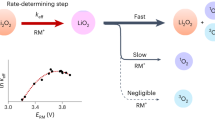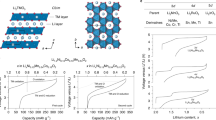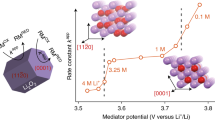Abstract
The non-aqueous Li–air (O2) battery is receiving intense interest because its theoretical specific energy exceeds that of Li-ion batteries. Recharging the Li–O2 battery depends on oxidizing solid lithium peroxide (Li2O2), which is formed on discharge within the porous cathode. However, transporting charge between Li2O2 particles and the solid electrode surface is at best very difficult and leads to voltage polarization on charging, even at modest rates. This is a significant problem facing the non-aqueous Li–O2 battery. Here we show that incorporation of a redox mediator, tetrathiafulvalene (TTF), enables recharging at rates that are impossible for the cell in the absence of the mediator. On charging, TTF is oxidized to TTF+ at the cathode surface; TTF+ in turn oxidizes the solid Li2O2, which results in the regeneration of TTF. The mediator acts as an electron–hole transfer agent that permits efficient oxidation of solid Li2O2. The cell with the mediator demonstrated 100 charge/discharge cycles.
This is a preview of subscription content, access via your institution
Access options
Subscribe to this journal
Receive 12 print issues and online access
$259.00 per year
only $21.58 per issue
Buy this article
- Purchase on Springer Link
- Instant access to full article PDF
Prices may be subject to local taxes which are calculated during checkout




Similar content being viewed by others
References
Abraham, K. M. & Jiang, Z. A polymer electrolyte-based rechargeable lithium/oxygen battery. J. Electrochem. Soc. 143, 1–5 (1996).
Bruce, P. G., Freunberger, S. A., Hardwick, L. J. & Tarascon, J-M. Li–O2 and Li–S batteries with high energy storage. Nature Mater. 11, 19–29 (2012).
Shao, Y. Y. et al. Electrocatalysts for nonaqueous lithium–air batteries: status, challenges, and perspective. ACS Catal. 2, 844–857 (2012).
Girishkumar, G., McCloskey, B., Luntz, A. C., Swanson, S. & Wilcke, W. Lithium–air battery: promise and challenges. J. Phys. Chem. Lett. 1, 2193–2203 (2010).
Scrosati, B., Hassoun, J. & Sun, Y. K. Lithium-ion batteries. A look into the future. Energy Environ. Sci. 4, 3287–3295 (2011).
Christensen, J. et al. A critical review of Li/air batteries. J. Electrochem. Soc. 159, R1–R30 (2012).
Chen, Z., Choi, J. Y., Wang, H. J., Li, H. & Chen, Z. W. Highly durable and active non-precious air cathode catalyst for zinc air battery. J. Power Sources 196, 3673–3677 (2011).
Black, R., Adams, B. & Nazar, L. F. Non-aqueous and hybrid Li–O2 batteries. Adv. Energy Mater. 2, 801–815 (2012).
Etacheri, V., Marom, R., Elazari, R., Salitra G. & Aurbach, D. Challenges in the development of advanced Li-ion batteries: a review. Energy Environ. Sci. 4, 3243–3262 (2011)
Ji, X. L. & Nazar, L. F. Advances in Li–S batteries. J. Mater. Chem. 20, 9821–9826 (2010).
Zhang, T., Imanishi, N., Takeda, Y. & Yamamoto, O. Aqueous lithium/air rechargeable batteries. Chem. Lett. 40, 668–673 (2011).
Lu, Y-C., Gasteiger, H. A. & Shao-Horn, Y. Catalytic activity trends of oxygen reduction reaction for nonaqueous Li–air batteries. J. Am. Chem. Soc. 133, 19048–19051 (2011).
Veith, G. M., Dudney, N. J., Howe, J. & Nanda, J. Spectroscopic characterization of solid discharge products in Li–air cells with aprotic carbonate electrolytes. J. Phys. Chem. C 115, 14325–14333 (2011).
Visco, S. J., Katz, B. D., Nimon, Y. S. & De Jonghe, L. C. Protected active metal electrode and battery cell structures with non-aqueous interlayer architecture. US Patent 7,282,295 (2007).
McCloskey, B. D. et al. On the efficacy of electrocatalysis in non-aqueous Li–O2 batteries. J. Am. Chem. Soc. 133, 18038–18041 (2011).
He, P., Wang, Y. G. & Zhou, H. S. A Li–air fuel cell with recycle aqueous electrolyte for improved stability. Electrochem. Comm. 12, 1686–1689 (2010).
Jung, H. G., Hassoun, J., Park, J. B., Sun, Y. K. & Scrosati, B. An improved high-performance lithium–air battery. Nature Chem. 4, 579–585 (2012).
Mizuno, F., Nakanishi, S., Kotani, Y., Yokoishi, S. & Iba, H. Rechargeable Li–air batteries with carbonate-based liquid electrolytes. Electrochemistry 78, 403–405 (2010).
Laoire, C. O., Mukerjee, S., Plichta, E. J., Hendrickson, M. A. & Abraham, K. M. Rechargeable lithium/TEGDME–LiPF6/O2 battery. J. Electrochem. Soc. 158, A302–A308 (2011).
Ogasawara, T., Debart, A., Holzapfel, M., Novak, P. & Bruce, P. G. Rechargeable Li2O2 electrode for lithium batteries. J. Am. Chem. Soc. 128, 1390–1393 (2006).
Choi, N-S. et al. Challenges facing lithium batteries and electrical double-layer capacitors. Angew. Chem. Int. Ed. 51, 9994–10024 (2012).
Mo, Y. F., Ong, S. P. & Ceder, G. First-principles study of the oxygen evolution reaction of lithium peroxide in the lithium–air battery. Phys. Rev. B 84, 205446 (2011).
Lu, Y-C. et al. The discharge rate capability of rechargeable Li–O2 batteries. Energy Environ. Sci. 4, 2999–3007 (2011).
Peng, Z., Freunberger, S. A., Chen, Y. H. & Bruce, P. G. A reversible and higher-rate Li–O2 battery. Science 337, 563–566 (2012).
McCloskey, B. D. et al. Twin problems of interfacial carbonate formation in nonaqueous Li–O2 batteries. J. Phys. Chem. Lett. 3, 997–1001 (2012).
Xie, B. et al. New electrolytes using Li2O or Li2O2 oxides and tris(pentafluorophenyl) borane as boron based anion receptor for lithium batteries. Electrochem. Comm. 10, 1195–1197 (2008).
Xu, W., Xiao, J., Wang, D. Y., Zhang, J. & Zhang, J. G. Crown ethers in nonaqueous electrolytes for lithium/air batteries. Electrochem. Solid State Lett. 13, A48–A51 (2010).
Shanmukaraj, D. et al. Boron esters as tunable anion carriers for non-aqueous batteries electrochemistry. J. Am. Chem. Soc. 132, 3055–3062 (2010).
Lacey, M. J., Frith, J. T. & Owen, J. R. A redox shuttle to facilitate oxygen reduction in the lithium air battery. Electrochem. Comm. 26, 74–76 (2012).
Giordani, V. Freely diffusing oxygen evolving catalysts for rechargeable Li–O2 batteries. Abstract for 16th International Meeting on Lithium Batteries, 2012, Jeju, Korea, S6-3 (2012).
Amine, K., Chen, Z. & Wang, Q. Redox shuttles for overcharge protection of lithium batteries. US Patent 7,851,092 (2010).
Chen, J., Buhrmester, C. & Dahn, J. R. Chemical overcharge and overdischarge protection for lithium-ion batteries. Electrochem. Solid State Lett. 8, A59–A62 (2005).
Bard, A. J. & Faulkner, L. R. in Electrochemical Methods. Fundamentals and Applications 811–812 (Wiley, 2000).
Chen, Y., Freunberger, S. A., Peng, Z., Barde, F. & Bruce, P. G. Li–O2 battery with a dimethylformamide electrolyte. J. Am. Chem. Soc. 134, 7952–7957 (2012).
Freunberger, S. A. et al. The lithium–oxygen battery with ether-based electrolytes. Angew. Chem. Int. Ed. 50, 8609–8613 (2011)
Freunberger, S. A. et al. Reactions in the rechargeable lithium–O2 battery with alkyl carbonate electrolytes. J. Am. Chem. Soc. 133, 8040–8047 (2011).
Wang, H. & Xie, K. Investigation of oxygen reduction chemistry in ether and carbonate based electrolytes for Li–O2 batteries. Electrochim. Acta 64, 29–34 (2012).
Ottakam Thotiyl, M. M., Freunberger, S. A., Peng, Z. & Bruce, P. G. The carbon electrode in nonaqueous Li–O2 cells. J. Am. Chem. Soc. 135, 494–500 (2012).
Trahan, M. J., Mukerjee, S., Plichta, E. J., Hendrickson, M. A. & Abraham, K. M. Studies of Li–air cells utilizing dimethylsulfoxide-based electrolyte. J. Electrochem. Soc. 160, A259–A267 (2013).
McCloskey, B. D. et al. Limitations in rechargeability of Li–O2 batteries and possible origins. J. Phys. Chem. Lett. 3, 3043–3047, (2012).
Sawyer, D. T., Chlericato, G., Angelis, C. T., Nanni, E. J. & Tsuchiya, T. Effects of media and electrode materials on the electrochemical reduction of dioxygen. Anal. Chem. 54, 1720–1724 (1982).
Peng, Z. et al. Oxygen reactions in a non-aqueous Li+ electrolyte. Angew. Chem. Int. Ed. 50, 6351–6355 (2011).
Woods, R. in Electroanalytical Chemistry, A Series of Advances Vol. 9 (ed. Bard, A. J.) 124–125 (Marcel Dekker, 1976).
Acknowledgements
P.G.B. is indebted to the Engineering and Physical Sciences Research Council, including Supergen, for financial support. The authors thank K. Dholaki, C. Thomson and P. Ashok for assistance with the SERS equipment.
Author information
Authors and Affiliations
Contributions
Y.C. and S.A.F. contributed equally to this work and carried out the experiments. Y.C. and Z.P. measured SERS. P.G.B. wrote the manuscript. All authors contributed to the discussion and interpretation of the results.
Corresponding author
Ethics declarations
Competing interests
The authors declare no competing financial interests.
Supplementary information
Supplementary information
Supplementary informatio (PDF 668 kb)
Rights and permissions
About this article
Cite this article
Chen, Y., Freunberger, S., Peng, Z. et al. Charging a Li–O2 battery using a redox mediator. Nature Chem 5, 489–494 (2013). https://doi.org/10.1038/nchem.1646
Received:
Accepted:
Published:
Issue Date:
DOI: https://doi.org/10.1038/nchem.1646
This article is cited by
-
The Linkage Between Electro-Chemical Mechanical Instabilities in Battery Materials
JOM (2024)
-
Why charging Li–air batteries with current low-voltage mediators is slow and singlet oxygen does not explain degradation
Nature Chemistry (2023)
-
Addressing Transport Issues in Non-Aqueous Li–air Batteries to Achieving High Electrochemical Performance
Electrochemical Energy Reviews (2023)
-
A molecular sieve-containing protective separator to suppress the shuttle effect of redox mediators in lithium-oxygen batteries
Nano Research (2023)
-
Fundamentals, preparation, and mechanism understanding of Li/Na/Mg-Sn alloy anodes for liquid and solid-state lithium batteries and beyond
Nano Research (2023)



